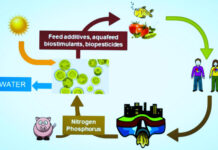Microalgae from upcycling star in a vegan ice cream rich in protein, vitamins and minerals.
The innovation stems from Sophie’s Bionutrients (Singapore) partnership with the Danish Technological Institute (DTI). (1)
Microalgae from upcycling
Microalgae flour from upcycling is the highlight ingredient of innovation in ice cream. Sophie’s Bionutrients grows them in three-day cycles, feeding the bioreactors with secondary streams from the food chain (spent grains, okara and molasses). (2)
Chlorella vulgaris
is the microalgae of choice. In addition to being a very promising superfood, as it turns out, chlorella has already been approved as a food ingredient in both the U.S. (as GRAS) and the European Union. (3)
Vegan ice cream rich in protein, vitamins and minerals
Ice cream made with protein concentrate from chlorella offers twice the recommended nutritional value of iron and vitamin B12 in a single serving. The nutrients and micronutrients that vegan consumers need most. The absence of dairy products also makes the ice cream accessible to people with milk allergies and/or lactose intolerance.
Thus, the technological challenge is to use natural and sustainable ingredients to impart texture and taste to vegan ice cream from microalgae. In a clean label logic, with no controversial additives and dyes or synthetic flavorings.
Chlorella, Olympic champion of sustainability
On the sustainability front, chlorella is an Olympic champion. Light years away from soybean, which is also still the
leader
in plant-based beverages.
One ton of protein from microalgae requires the use of only 0.02 hectares of soil. And it is therefore that its production also takes place easily in metropolitan areas.
After all, contamination risks are easy to control in the biofarm without the need for herbicides, fertilizers, antibiotics or hormones.
Microalgae, precedents and prospects for innovation
Sophie’s BioNutrients debuted a microalgae-based milk replacement product. An ingredient that has already shown numerous successful applications, from vegan alternatives to cheddar and hamburger to ice cream. The company thus opened a new headquarters in Wageningen, NL, the beating heart of European food innovation.
Algae and microalgae, as noted, are supported by the European Commission both in research projects (e.g., ProFuture) and in the recent Communication for the creation of a European algae industry.
Marta Strinati and Dario Dongo
Notes
(1) See Sophie’s Bionutrients statement on LinkedIn https://bit.ly/3ir0CAE
(2) Food waste includes cereals remaining from brewing, soybean paste (okara) remaining from tofu production, and molasses remaining from sugar production
(3) Dario Dongo, Giulia Torre. Microalgae for food use and Novel Foods regulation, the state of the art in the EU. GIFT (Great Italian Food Trade). 29.1.22








